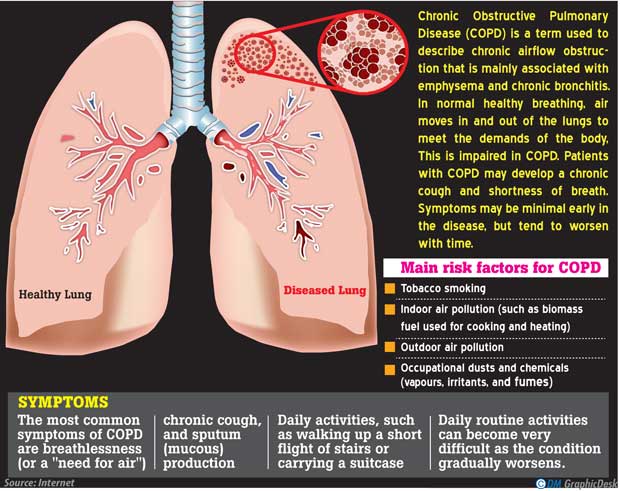Reply To:
Name - Reply Comment
 “People who are COPD patients should understand that it is not the end of the world for them. Pulmonary rehabilitation is available in many hospitals which will help them lead comfortable and better quality lives. Refrain from giving up,”
“People who are COPD patients should understand that it is not the end of the world for them. Pulmonary rehabilitation is available in many hospitals which will help them lead comfortable and better quality lives. Refrain from giving up,”
-Dr. Keerthi Gunasekera
November hosts numerous world health days. World Chronic Obstructive Pulmonary Disease (COPD) Day is yet another which fell on November 15. This calls for the spotlight on COPD. It’s a disease that strongly impacts the life of a patient. Lifelong treatment is required if someone falls prey to the ailment, in order to avoid fatal conditions. But where there’s life, there is hope and it’s the same regarding this situation. Dr. Keerthi Gunasekera, Consultant Respiratory Physician at the Central Chest Clinic and National Hospital of Sri Lanka, Colombo, spoke to Health Capsule regarding COPD.
“Chronic Obstructive Pulmonary Disease (COPD) is a condition that affects the airways of the respiratory system. This includes the breathing tubes of the lungs. It causes damage to the lungs itself, affecting the lung tissue (lungparenchyma),” Dr. Gunasekera explained. “Unlike asthma, where the disease is limited to affecting the breathing tubes, COPD affects the entire lung itself,” he added further.
Exposure to a poisonous or toxic agent on a long term basis can create irritation of the airways and lung tissue leading to COPD. “The malady is similar to asthma in terms of the airways becoming narrower and an obstruction caused to the air flow through these airways.This impedance in the air flow results in a difficulty in breathing,” he said.

Asthma and COPD, are they similar?
Dr. Gunasekera explained that in asthma patients, the respiratory airways tighten at night, causing difficulty to breathe. But during the day, the airways dilate back to normal and breathing returns to normalcy. In this case, the narrowing of the airways in asthma is reversible. “But where COPD is concerned, the tightening of the airways is an irreversible progressive condition where breathing is obstructed and inflammation is caused,” he said.
Substances known as allergens trigger asthma. According to Dr. Gunasekera, an allergen could be pollen, house dust, etc that could arouse asthma. “COPD is caused by long term exposure to noxious or toxic substances. This results in irritation and permanent damage to the lungs,” he added.
Speaking on the causes of COPD, Dr. Gunasekera listed that smoking, exposure to toxic fumes on a long term basis and people with premature births are more susceptible to COPD. “Not all smokers get COPD though. Non smokers also fall victim to COPD. According to studies in China,exposure to fire wood fumes when cooking with a hearth is also seen as a cause of the disease.Therefore females at homes, without ventilation, can also develop COPD when exposed to firewood fumes. There is a genetic implication as well. A family history of COPD might mean that a person may be susceptible to COPD. Environmental factors also affect the contraction of the disease,” Dr. Gunasekera stressed.
COPD is a progressive disease. The predominant symptom is the shortening of breath.Coughing is another sign. Wheezing may or may not be present.
Are you suffering from copd?
According to Dr. Gunasekera, spirometry is used in the diagnosis of COPD. It is the testing of lung functioning. The obstruction of the airways is measured through the test. “A healthy person is able to expire 80% of air in the lungs in one second.If the airways of the lungs are narrowed, the volume of expired air will be less than 80%. So a patient is asked to breathe out as much air as possible. If the exhaled volume of air is less than 80%, it indicates an obstruction in the lung airways. This raises suspicions that the patient suffers from either asthma or COPD. A bronchodilator is used to confirm the ailment. A bronchodilator stimulates dilation of the airways. The patient will be tested again to measure the volume of exhaled air. If the volume is 80% or more after the use of the bronchodilator, it can be confirmed that the patient suffers from asthma. If the volume doesn’t still reach a level of 80%, the patient suffers from COPD,” he accentuated. The reason behind this is that the tightening of airways is reversible in asthma but is not so in COPD.
Dr. Gunasekera mentioned that the progression of this condition is divided into stages (stage 1, 2, 3, 4 etc). The severity level of COPD is determined by the percentage of air that a person is able to breathe out from the total volume of air in the lungs. “If a person breathes out less than 30%, then the patient suffers from very severe COPD. If it lies within the range of 30% -50%, then it is moderate COPD. If the reading is in the range of 50% -80%, then the patient is in the early or mild stage of the disease,” he informed.
Emphysema is a consequence of COPD. It’s the over inflation of the lungs.”Expiration doesn’t take place efficiently due to the narrowing of airways, resulting in trapping of air in the lungs. This can be seen in a chest x-ray. The diaphragm appears to be pushed down, the heart is narrower and the x-ray appears blacker,” the doctor stated.
Treatment is the key
COPD can’t be completely cured as the process can’t be reversed. But the progression of the disease can be stopped. “Cessation of smoking is important. Bronchodilators will be recommended, but they may not prove very effective for some patients. In later stages of the disease, patients will be extremely short of breath as their oxygen levels are low. So home oxygen will be necessary. When lungs get overstretched, pressure is applied on blood vessels and ultimately pressure builds up on the heart, causing pulmonary hypertension, and leads to heart failure on the right side of the heart. This is known as Cor Pulmonale. This is a cardiac disease secondary to lung disease,” stressed Dr. Gunasekera.
These patients are given oxygen in low doses. There are high levels of carbon dioxide in these patients which they can’t expirate. Their bodies get used to the high levels of carbon dioxide. So their respiratory drive depends on carbon dioxide. Hence, they respond to low oxygen levels. Dr. Gunasekera warned that if high dose oxygen levels are given to these patients, their respiration stops.
Not all smokers get COPD though. Non smokers also fall victim to COPD. According to studies in China,exposure to fire wood fumes when cooking with a hearth is also seen as a cause of the disease.Therefore females at homes, without ventilation, can also develop COPD when exposed to firewood fumes
Treatments include oral drugs such as bronchodilators, inhalers and sometimes steroids (but they may not be as effective as in asthma). “Pulmonary rehabilitation is a very vital part of treatment. COPD patients can’t exert themselves much, as they become breathless at the slightest exertion. Pulmonary rehabilitation teaches patients how to breathe, walk, exercise, etc helping them to improve their physical condition. Exercise is especially vital for these patients and pulmonary rehabilitation ensures that these patients exercise in appropriate manners which suits them,” he clarified.
The lung functioning of these patients are greatly affected by infections. This could lead to lung damages. If a patient is affected severely more than twice by infections, they might have to get hospitalized and their survival time may be less. They will not be able to return to normalcy. Mortality is high.
So it is important to protect these patients from falling victim to infections. “COPD patients are vaccinated against influenza. They are vaccinated with the Hib influenza vaccine as well as the pneumococcal vaccine against pneumonia,” informed the doctor.
Preventive measures include avoiding habits such as smoking. It is important to take precautions to prevent inhalation of toxic substances over long periods of time.
Are you at risk?
When asked about the risk groups, Dr. Gunasekera mentioned that COPD is usually not seen in children. “It is seen more in people above the age 40. In 2013-2014, an islandwide study was conducted on Obstructive Lung Diseases (OLD). Using spirometry, they conducted the study among 2000 people. 10.5% of the people were found to be COPD patients. The value 10.5% is quite high,” he stressed.